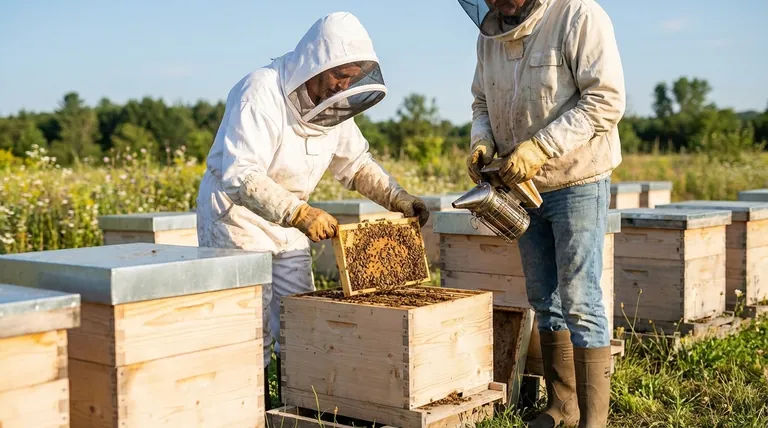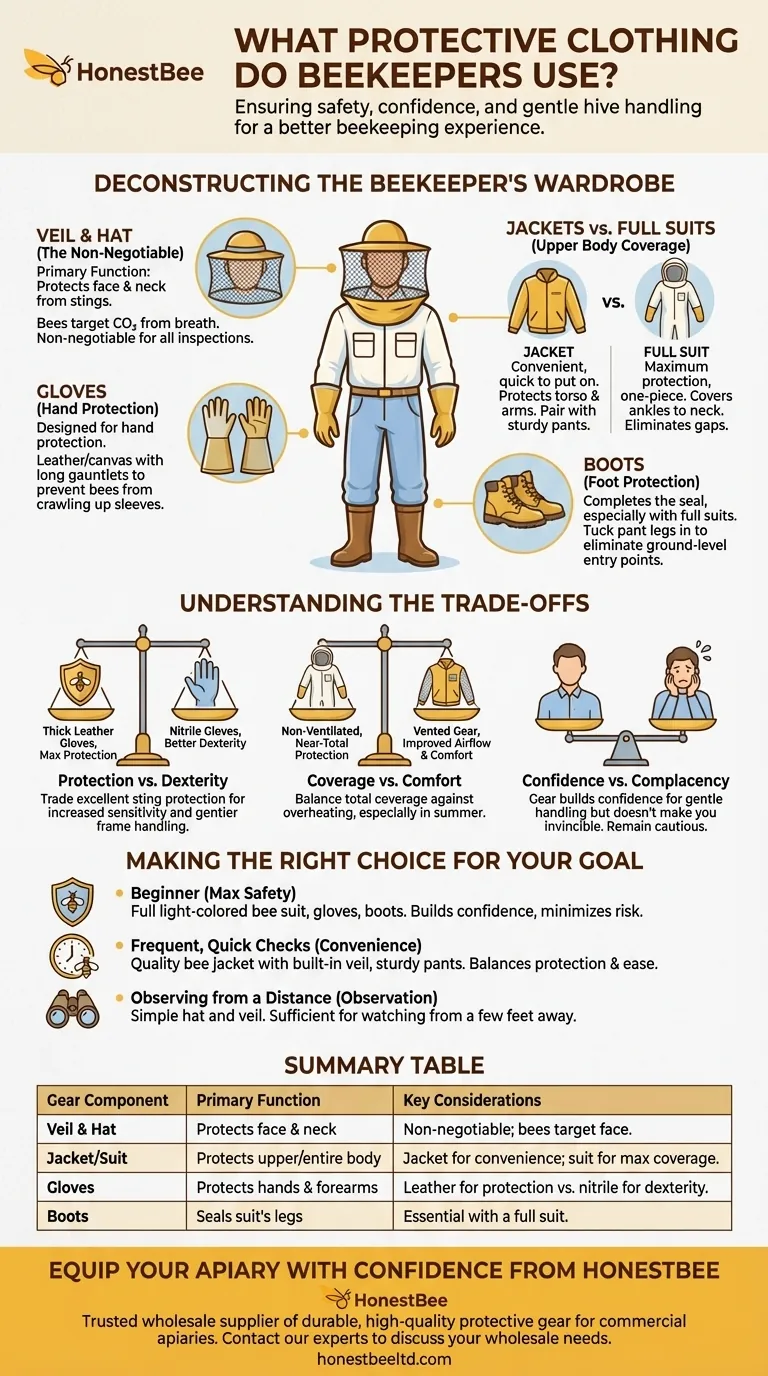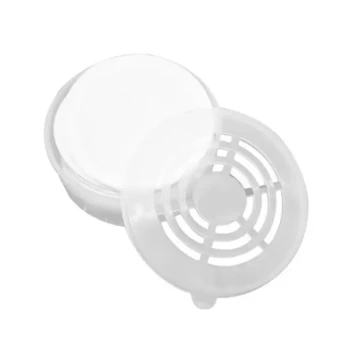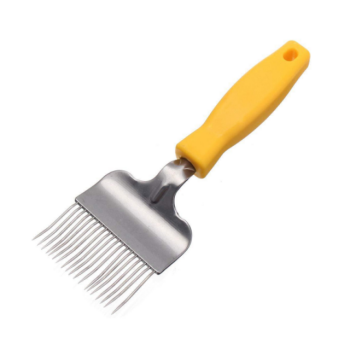Beekeepers primarily use a combination of a veil, a specialized suit or jacket, and gloves to protect themselves from stings. The specific combination and level of protection vary, but the absolute minimum for any hive inspection is a veil to shield the face and neck.
Your goal is not simply to prevent stings, but to create a calm and safe environment for both you and your bees. The right protective clothing is a tool that builds your confidence, which in turn leads to gentler handling and a better beekeeping experience.

Deconstructing the Beekeeper's Wardrobe
Protective gear exists on a spectrum from minimum essential coverage to full-body armor. Understanding the role of each component allows you to make an informed decision based on your hive's temperament and your personal comfort level.
The Non-Negotiable: The Veil and Hat
The single most critical piece of protective equipment is the veil. Bees often target the face because they are drawn to the carbon dioxide you exhale, and stings to the eyes, nose, or mouth are uniquely dangerous and painful.
A veil is almost always attached to a hat or integrated into a jacket's hood. This combination ensures a secure barrier around your head and neck, which are the most vulnerable areas.
Upper Body Coverage: Jackets vs. Full Suits
For body protection, beekeepers choose between a jacket or a full suit.
A beekeeping jacket is a popular and convenient option. It provides excellent protection for the torso and arms and almost always includes an integrated veil. It can be quickly put on over regular clothes, making it ideal for fast inspections. Most beekeepers pair a jacket with thick jeans or cotton pants.
A full beekeeping suit offers the highest level of protection, covering you from your ankles to your wrists and neck. These one-piece garments eliminate any gaps between a shirt and pants where a bee could enter, providing maximum peace of mind, especially for beginners.
Hand and Foot Protection: Gloves and Boots
Beekeeping gloves are designed to protect your hands while you work. They are typically made of leather or thick canvas and extend up the forearm with a long gauntlet to prevent bees from crawling up your sleeves.
Boots, especially when worn with a full suit, complete the seal. Tucking your suit's pant legs into a pair of ankle-high boots ensures there are no entry points for determined bees near the ground.
Understanding the Trade-offs
Choosing your gear involves balancing competing priorities. There is no single "best" setup; there is only the best setup for a specific beekeeper and a specific situation.
Protection vs. Dexterity
Thick leather gloves offer excellent sting protection but can feel cumbersome. This lack of sensitivity can cause you to be less gentle when handling frames, which can agitate the bees. For this reason, some experienced beekeepers prefer using thinner nitrile gloves, accepting a higher risk of stings in exchange for better dexterity.
Coverage vs. Comfort
A full, non-ventilated suit offers near-total protection but can become incredibly hot, especially during summer inspections. A vented suit or jacket, made of layered mesh, provides a significant improvement in airflow and comfort while still offering excellent protection. A jacket is inherently cooler than a full suit but leaves your legs more vulnerable.
Confidence vs. Complacency
While gear is critical, it doesn't make you invincible. A bee can occasionally sting through a suit or find a tiny gap. The true value of protective gear is the confidence it gives you. A calm beekeeper is a gentle and methodical beekeeper, which results in calmer bees and a more pleasant experience for everyone.
Making the Right Choice for Your Goal
Your choice of gear should align with your experience level and the specific task at hand.
- If your primary focus is maximum safety as a beginner: A full, light-colored bee suit with gloves and boots is the best choice to build confidence and minimize risk.
- If your primary focus is convenience for frequent, quick checks: A quality bee jacket with a built-in veil, paired with sturdy pants, offers a fantastic balance of protection and ease of use.
- If your primary focus is observing from a distance: A simple hat and veil may be all you need to safely watch hive activity from a few feet away.
Ultimately, the right protective clothing is the gear that allows you to work calmly and confidently with your bees.
Summary Table:
| Gear Component | Primary Function | Key Considerations |
|---|---|---|
| Veil & Hat | Protects face and neck from stings. | Non-negotiable; bees target the face. |
| Jacket vs. Full Suit | Protects the upper body or entire body. | Jacket for convenience; suit for maximum coverage. |
| Gloves | Protects hands and forearms. | Leather for protection vs. nitrile for dexterity. |
| Boots | Seals the suit's legs to prevent bee entry. | Essential when wearing a full suit. |
Equip Your Apiary with Confidence from HONESTBEE
As a trusted wholesale supplier to commercial apiaries and beekeeping equipment distributors, HONESTBEE provides the durable, high-quality protective gear that professionals rely on. We understand that your productivity and safety depend on equipment that performs under demanding conditions.
Let us help you outfit your team with the right gear for maximum safety and efficiency. Contact our experts today to discuss your wholesale needs and explore our full catalog of beekeeping supplies and equipment.
Visual Guide

Related Products
- Wholesales Dadant Size Wooden Bee Hives for Beekeeping
- Yellow Plastic Bucket Pail Perch for Beekeeping
- Long Langstroth Style Horizontal Top Bar Hive for Wholesale
- Professional Insulated Winter Hive Wrap for Beekeeping
- Professional Bee Smoker with Elongated Spout and Durable Bellows for Beekeeping
People Also Ask
- What are the advantages of wooden bee hives? Superior Bee Health & Beekeeper Flexibility
- How often should the area under beehives be inspected and cleaned during the warm season? A Proactive Maintenance Guide
- Why were wooden hives traditionally preferred? For Natural Beekeeping Aligned with Bee Biology
- What is beekeeping equipment? Essential Tools for Commercial Apiaries & Distributors
- What types of products are available for beekeeping needs? Essential Equipment for Apiaries & Distributors



















